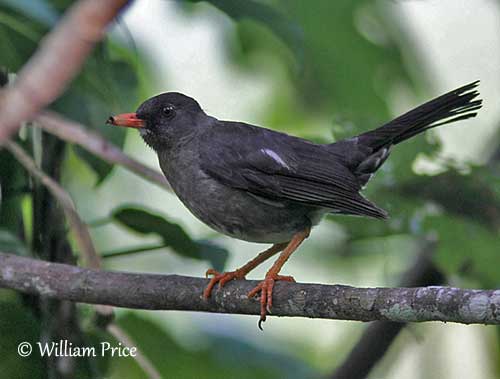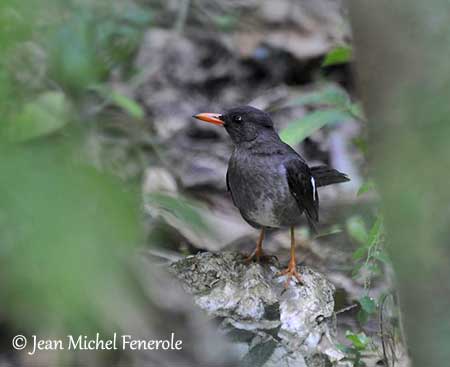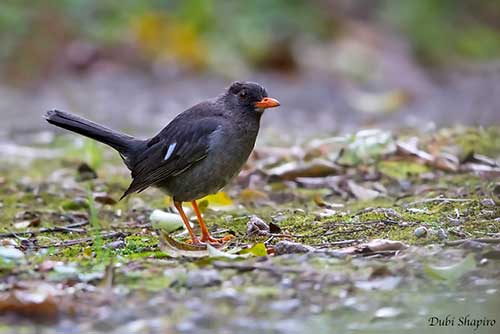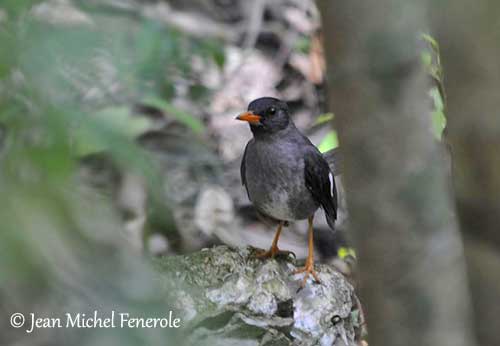
Fr: Merle à miroir
Ang: White-chinned Thrush
All: Weißkinndrossel
Esp: Zorzal Gorgiblanco
Ita: Tordo mentobianco
Nd: Witkinlijster
Sd: vithakad trast
Photographers:
Jean Michel Fenerole
Photos d’Oiseaux du monde
William Price
PBase-tereksandpiper & Flickr William Price
Dubi Shapiro
Dubi Shapiro Photo Galleries & Dubi Shapiro's Pictures on IBC
Text by Nicole Bouglouan
Sources:
HANDBOOK OF THE BIRDS OF THE WORLD Vol 10 by Josep del Hoyo-Andrew Elliott-David Christie - Lynx Edicions - ISBN: 8487334725
THRUSHES by Peter Clement and Ren Hathway – HELM - ISBN: 0713639407
BIRDS OF THE WEST INDIES – by Herbert Raffaele, Kristin Williams et Tracy Pedersen – Helm – ISBN: 9780713649055
Neotropical Birds – Cornell Lab of Ornithology
White-chinned Thrush
Turdus aurantius
Passeriformes Order – Turdidae Family
INTRODUCTION:
The White-chinned Thrush is endemic to Jamaica where it is fairly common. It frequents a variety of woodlands in hills and mountains, forest edge and scrub. It feeds on various invertebrates and small vertebrates, lizards and fruit. It forages mainly on the ground, a typical behaviour of Turdidae. It nests in a bulky structure placed in vegetation, and produces two broods per season.
The White-chinned Thrush has restricted range but it is not globally threatened and its population is currently stable.
DESCRIPTION OF THE BIRD:
Biometrics:
Length: 24-27 cm
Weight: 82 g
The White-chinned Thrush adult has glossy dark grey plumage on head and upperparts, with white wing patch formed by two broad white edges to innermost greater coverts. Mantle, back, scapulars, rump and uppertail-coverts are dark grey with brown tinge. Wings and tail are darker, mostly uniformly brown.
On the underparts, the chin is whitish (giving the bird its name) whereas the throat is grey-brown. The underwing-coverts are greyish-black with pale edges. Rest of underparts is greyish-buff but belly and vent are whitish. The breast feathers may show whitish tips. The undertail-coverts are grey-brown, sometimes with white tips.
On the head, forehead, crown, nape and face are dark grey. The face may sometimes appear paler, with streaks or flecks, but other birds have dark face.
The bill is bright yellow-orange or deep orange with blackish tip. The eyes are brown to orange-brown. Legs and feet are yellowish orange.
Male and female are similar.

The juvenile resembles adult but it has mostly reddish-brown crown to upperparts, and also breast and flanks. The white chin patch is smaller or absent, but the white wing patch is present although less extensive.
RANGE:
The White-chinned Thrush is found in Jamaica.
HABITAT:
The White-chinned Thrush frequents primary and secondary forests, forest edge and scrub in hills and mountains. It is present in citrus and banana groves, pastures, cultivated areas and gardens in mountains, from middle to high elevations.
However, in N and SW coasts, it may occur at sea-level, although it is less frequent in lowlands.

CALLS AND SONGS: SOUNDS BY XENO-CANTO
The White-chinned Thrush gives shrill sounds in alarm, very similar to the calls of the Common Blackbird (T. merula).
The slow and lilting song includes shrill, drawn-out ascending notes repeated indefinitely “ture-tee-too-too-tee-tee”. This song recalls again the Common Blackbird (T. merula) but also the American Robin (T. migratorius) but it is much richer in tone and more plaintive too.
We can also hear a deep, monotonous “kek” often repeated, and some shrill whistles “pliss-pliss”.
BEHAVIOUR IN THE WILD:
The White-chinned Thrush typically feeds on a variety of invertebrates such as worms, slugs, beetles and moths with their larvae, but frogs, small mice and lizards are also taken, alongside fruit and berries.
It forages generally on the ground and it is often seen along roadsides, especially after rain. It spends long periods on the forest floor.
On the ground but also when perched in tree, the tail is often uptilted or semi-erect over the back, like the Red-legged Thrush (T. plumbeus). The wings are usually drooped at body sides.

The courtship displays are not described. However, the male is more vocal during the breeding season, and often gives melodious song including shrill whistles in order to proclaim the territory. They are probably monogamous and territorial.
The White-chinned Thrush is sedentary with some dispersion to lower elevations in winter.
The flight is low and fast.
REPRODUCTION OF THIS SPECIES:
The breeding season takes place between May and July/August.
The White-chinned Thrush builds a bulky cup with leaves, plant fibres, twigs and interwoven pieces of bamboo or banana. The cup is lined with softer materials. This nest is usually placed in shrub, tree and bromeliad or at base of palm frond.
The female lays 2-4 whitish to pale green eggs with dark markings. The incubation lasts two weeks.
A second brood is laid about ten days after the first young fledge.
PROTECTION / THREATS / STATUS:
The White-chinned Thrush has restricted range, but it is common and widespread. It was formerly trapped for food by humans, but today, the species is not globally threatened.
The White-chinned Thrush is currently evaluated as Least Concern.
